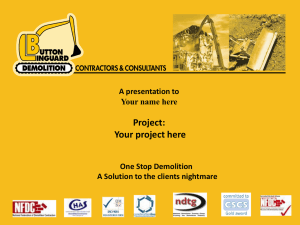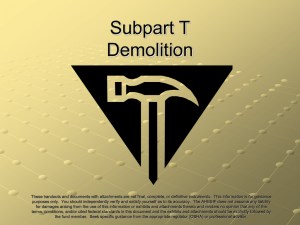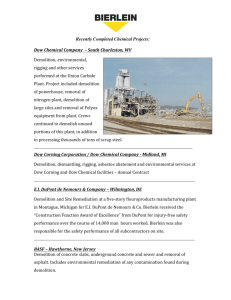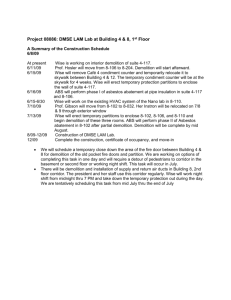Controlled demolition of reinforced concrete
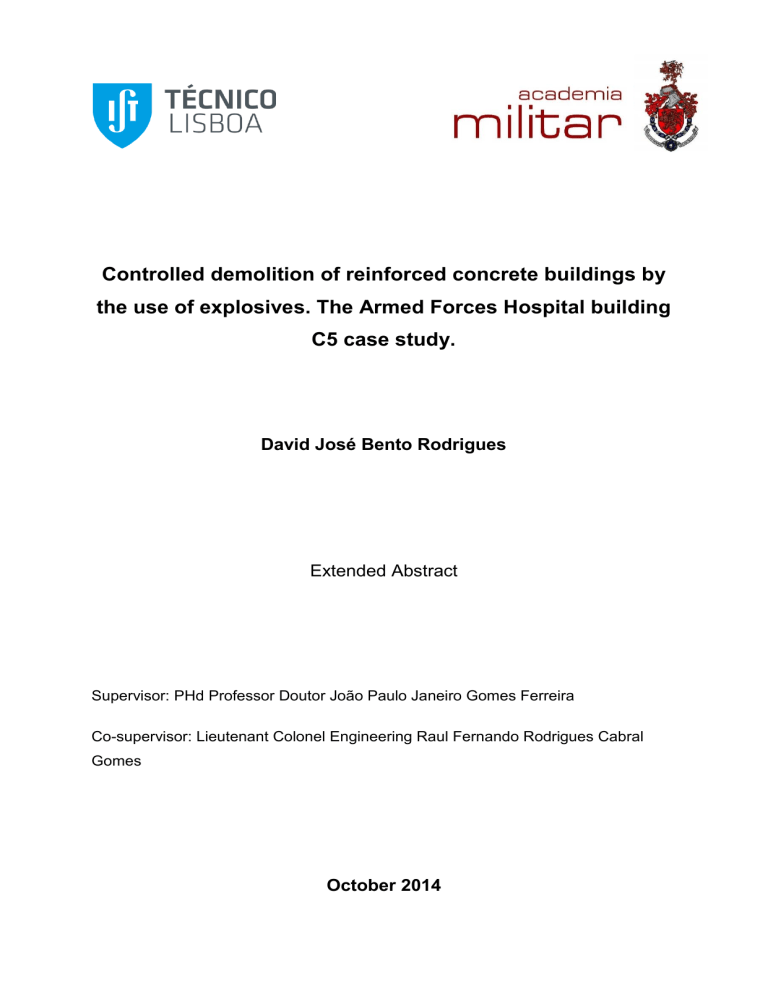
Controlled demolition of reinforced concrete buildings by the use of explosives. The Armed Forces Hospital building
C5 case study.
David José Bento Rodrigues
Extended Abstract
Supervisor: PHd Professor Doutor João Paulo Janeiro Gomes Ferreira
Co-supervisor: Lieutenant Colonel Engineering Raul Fernando Rodrigues Cabral
Gomes
October 2014
Extended Abstract
Abstract
As time advances structures in Portuguese built areas start to show high levels of degradation. When rehabilitation is no longer a viable option these structures need to be demolished.
Given the reduced knowledge of the use of demolition methods by explosives in Portugal, this study seeks to compensate existing flaws in the project and execution phases.
This study starts with a brief introduction, wherein the explosive demolition project methodology is analysed, highlighting the calculation method used which is the base of the software used to model the collapse mechanism, as well as the calculation of the explosive charges. A case study is also analysed allowing understanding all the sequential work done prior to the demolition, in essence its planning and execution. The main impacts of this type of demolitions are also discussed and how these are both controlled and minimised. Finally, a comparative economic analysis between explosive demolitions and traditional demolitions is performed.
All demolition methods have their applications, advantages and disadvantages. However, the explosive demolition methods applied to high reinforced concrete buildings can be a viable solution due to the advantages they present in these situations when compared to other methods.
Keywords : explosive method, traditional method, structure demolition, reinforced concrete building
1
Explosive demolition of reinforced concrete buildings
1. Introduction
Engineering is not only about construction but also about demolition, enabling existing space to be reused. Demolition can thus be defined as a set of removal works to be applied to an existing structure leading to a new space availability. Demolition work can be partial or global and can be used on new or old structures (Brito, 1999).
One of the possible methods to be used is controlled demolition using explosives, which was developed in Europe throughout the reconstruction of the cities that were destroyed during the second
World War. Due to its advantages it later spread to the rest of the world (Jimeno et al.
, 1995), although it is a technique that is still little used in Portugal.
This study has the objective of understanding how controlled demolition using explosives projects are executed, highlighting the calculation method used by the demolition program and the calculation of the explosive charges. All of the aspects during the preparation and execution of the program are also looked at through the analysis of a case study. A cost analysis is also made in order to be able to compare explosive demolition costs to more traditional demolition costs.
2. Explosive demolitions methods
The use of explosive demolitions has grown over the years, not only in building demolition but with other types of structures like metal or reinforced concrete structures as well. Considered to be a fast, practical and economical alternative to traditional demolitions, its main focus is the use on large structures such as sky-scrapers, chimneys, and silos, large solid reinforced concrete structures like naval infrastructure foundations, and even the quick demolition of bridges (Lauritzen & Schneider,
2000, cited by Gomes, 2010).
Explosive demolitions consist of using controlled explosives by placing small explosive charges
(generally less than 50 g), which are usually placed in the structural elements that are to be demolished and confined to drillings made for this purpose (Jimeno et al.
, 1995; Gomes, 2010).
After this placement the charges are detonated through an initiation system. The explosive charges present in the vertical elements detonate, causing a “structural vacuum” called a demolition belt, within which through gravity the structure collapses, fragmenting due to its own weight, or, when appropriate, enabling it to fall on one side, enabling easier access to the debris which can then be taken apart using traditional methods (Gomes, 2000).
So as to obtain a controlled demolition, one where the structure when demolished acts as predicted, it is necessary to choose the correct collapse mechanism. Existing collapse mechanisms are implosion, telescopic, tumbling, and progressive collapse.
2
Extended Abstract
Whenever explosive demolition methods are used there is the need for preparatory work. This are meant to facilitate the demolition process, improve the control of the collapse mechanism, reduce the quantity of explosives needed and limit possible damage caused through the removal of components that could be dangerous during the detonation or the removal of the debris. Some of the prep work is: implementation of the construction site, sterilization, pre-weakening, charge tests, trial fire, determining devices and explosive quantities, drilling of the elements to be demolished and the placing of containment systems of fragments at the source.
An explosive can be defined as a substance, or a mixture of substances, susceptible to rapid changes with an extremely short time frame (centiseconds or milliseconds) during which a large volume of gas is produced (hundreds or thousands of time superior to the volume that the explosive occupied) and energy is released, usually in the form of heat (Barros, 1984). When the speed of transformation is within cm/s the explosion is considered combustion, and when it is between 100 and 1000 m/s it is considered deflagration, and if it occurs at a speed of 2 to 9 km/s it is designated as an explosion. This explosion occurs due to the action of a stimulus, known as initiation, which is generally small and can be achieved through percussion, shock, friction, heat or sympathy explosion. Devices called detonators are used for this initiation, and via a primary explosive charge a chemical chain reaction leads to a secondary explosion, which in turn detonates the explosive charge. These initiation systems can be electrical, non-electrical (pyrotechnic, NONEL and detonating cord) and electronic.
3. Explosive demolition project
3.1. Project Phases
The starting point for an explosive demolition project is the selection of the collapse mechanism, as this is the key element in defining the preparation work for the structure, specifically the preweakening, drilling, definition of the firing system and impact control measures (Gomes, 2013). To identify the collapse mechanism three factors that influence its choice are surrounding, structural and environmental evaluation .
Gomes (2000), cited by Brown (1995) refers that, the objective of defining the correct collapse mechanism is to obtain an efficient controlled collapse, maximise structure fragmentation, control material projections and avoid damage to adjacent infrastructures.
During the execution of the explosive demolitions project, modelling is done through the use of software, so that the behaviour of the structure during the collapse can be understood and to subsequently define the timings that lead to the fire plan. At the same time the explosive charges necessary to create the demolition belt and the collapse mechanism are calculated, and these are
mechanism.
3
Explosive demolition of reinforced concrete buildings
Figure 3.1 - Definition of the collapse mechanism and the explosive demolition project phases
A further objective is to determine the fire plan, as well as the element to drill and fill with explosives, how to cause as little disturbance as possible, both before and after the event, by reducing material projections, shockwaves and ground vibrations. The values obtained are then used in the three evaluations referred to previously.
3.2. Applied Element Method
Computer assisted simulation is an important tool to ascertain the behaviour of buildings subject to extreme conditions such as earthquakes, structural impacts, explosions or progressive collapses, as in the case of demolitions. To make up for existing weaknesses in the finite element method (FEM) and the discrete element method (DEM), a new method, Applied Element Method (AEM) was developed, which is capable of predicting with a high degree of precision continuous and discrete structural behaviour, which is the basis of Extreme Loading for Structures (ELS), software owned be Applied
Science International (ASI).
The applied element method manages the behaviour of structural collapses over different phases, automatically calculating all of the elastic stage, crack initiation and propagation, reinforcement yielding, formation of plastic nodes, buckling and post-buckling, separation of elements, the collision/contact between elements and the collision with the ground and adjacent structures (Lupoae,
2009; ASI, 2006).
In the applied element method, the structures are modelled as a set of reduced elements, which arise
4
Extended Abstract of springs, of normal and shear springs, which are located at contact points and distributed over the
sides of the two elements (Figure 3.2 c)).
Concrete spring
Volume represented by one axial spring and two shear stress springs.
Steel spring a) b) c)
Figure 3.2 - Structural model of the AEM: a) Structure; b) Elements created by the AEM; c) Distribution of the springs (Adapted: Tagel-Din, 2009)
One of the great innovations in terms of the characteristics of the AEM is the automatic detection of contact among elements, as well as the dissipation of energy when contact occurs among the elements and the ground. Another characteristic of the AEM is the creation of independent meshes for each element, which makes the entire modelling process much quicker, as it is not necessary to adjust the mesh of other elements (Tagel-Din, 2009).
3.3. Explosive charges
As previously referred to in 3.1, the explosive charges are calculated simultaneously with the modelling and the pre-weakening processes being especially relevant its calculation as it is necessary to create the demolition belt, which can then cause the collapse mechanism and therefore the demolition to occur as predicted.
One of the methods used by the designers for the calculation of the explosive charges is usually of an empiric nature based on the personal experience of each individual (Kasai, 1988). From this comes the specific charge method , which is based on the concept of the specific charge (Qe), which represents an estimation of the weight of explosives that is necessary to fragment a cubic meter of the element to be demolished, in terms of the demolition belt that is to be used for each vertical element.
The specific charge is distributed equitatively among each drilled space in the element (Gomes, 2010).
Gomes (2010) states that, according to the cross-section, confining and axial stress, mechanical properties of the element and, especially, the percentage of reinforcement, the specific charge value is between 0,50 kg/m
3
and 1,5 kg/m
3 per structural element, columns and walls. However, specific charges should be adjusted to each case according to trial fire.
5
Explosive demolition of reinforced concrete buildings
Another calculation method, the Portuguese method for charge calculation , developed by Gomes
(2010)
1
, is a method which is based on an older empirical expressions
2
and tests on real models, and also results in an empirical formula. Through this formula it is possible to calculate the charge necessary to fragment sections of stone or reinforced concrete, according to spacing between drill points, specific characteristics of elements (concrete resistance, reinforcement, among others) and the geometry of the section.
As such, the following equation is used to calculate the quantity of explosive necessary to fragment a section (equation 3.1) (Gomes, 2010):
𝑄 = 𝑅 2 × 𝐾 × 𝐿 (3.1)
In which:
𝑄 – Explosive charge per drill (kg) using TNT. This parameter does not take into account possible defects drill covers, considering it perfect, not taking any aggravating coefficient for this factor ;
𝑅 – Width of the gap chosen by the designer [m]. This usually corresponds to the distance from the centre of the drill to the exposed face (columns) or to half the space between drills in square grids, for example in solid concrete elements;
𝐾
𝐿 – Section length [m].
Table 3.1 - Values for K for reinforced concrete columns and walls (Gomes, 2010)
K
– Reinforced concrete columns and walls
% of reinforcement
Hoops
1%
8 // 25-30 cm
2%
8 // 10-15 cm
3%
8 // 10-15 cm
Medium
– Good
4%
8 // 10 cm
Concrete Quality Weak - Medium Medium Good - Very good
K 2,05 4,02 6 7,97
NOTES: The values for K can be reduced if the element hoops are lower than considered above, i.e. if spacing is greater than indicated. Excluded from this adjustment is the value of K (1%) that should not be optimised but possibly increased if the concrete is of good quality.
4. Case Study
– HFAR Building C5
The objective of this chapter is to present a real case study of the demolition of a reinforced concrete building using explosive demolition methods. The case study was building C5 of the Armed Forces hospital, and the demolition process was accompanied by the author from start to the end.
The building consisted of two approximately symmetrical elements, separated by an expansion joint, and there were two floors above ground level and accessed via stairways. The roof was inclined and
1
Developed by Gomes (2010) in the Explosives and Counter-Measures Training Centre of the Engineering
Practical School, current Engineering Regiment n.º 1.
2 The empirical formula used as the basis is known among military engineers as the “miners formula”.
6
Extended Abstract not accessible. There was also a small underground basement. The building had a large site area of approximately 620 m
2
Figure 4.1 - Building C5
Compared to a conventional mechanical demolition, this method took substantially less time and work volume, and limited the impact of the demolition (dust, noise, accident risk, safety, vibration transmission) almost exclusively to the duration of the collapse and removal of the debris.
In terms of the available space for the debris, and taking into account the building type and the collapse mechanism chosen, the existing surrounding area was sufficient for the debris area, not exceeding a total area of 1000 m
2
, being deposited approximately in the area that the building had occupied.
4.1. Description of the demolition
The explosive demolition of the HFAR C5 building had the following phases: construction site implementation, structure sterilisation, structural pre-weakening, source containment works, placing of explosive charges, detonation, and removal of the debris. The placing of the explosive charges and consequent detonation can only be done after all previous phases have been concluded, and the other phases were all done through conventional mechanical means.
The collapse of the structure was achieved by the detonation of the internal explosive charges that were placed in all the vertical structural elements (columns and walls) on the ground floor and the first floor. Timers with 400 ms intervals were introduced for the initiation process, so as to ensure that the progressive collapse mechanism calculated ensued. The use of timers means that there was less vibration transmission to the ground as there is less mass that simultaneously impacts, which leads to a reduction in the pressurised wave that comes from the detonation and maximises the stress increase due to bending.
The Extreme Loading for Structures software is used to validate the defined collapse mechanism, and with it, it’s possible to understand the behaviour of the structure during the collapse and also improve the initial fire plan, so that structure fragmentation is as much as possible and that the whole process is carried through safely and as planned.
7
Explosive demolition of reinforced concrete buildings
It was initially predicted through the models that there would be reduced fragmentation of nondetonated structural elements due to the building’s low height. However, after the demolition these elements became accessible by mechanical means and could be easily dismantled.
The initiation system in this case study was carried out using a mixed system, which consisted of
electronic and non-electrical detonators (NONEL) as illustrated in Figure 4.2.
Figure 4.2 - Schematics of the initiation system
All of the surface networks, installations and infrastructures that were to remain operational after the demolition, such as the water and electrical supply networks, pavements and paved roads, were protected by the use of a 60 cm dissipation layer using materials from the sterilisation phase.
The quantity of fragmentation charges used to create the demolition belt of the vertical elements was
obtained through the use of the methods in chapter 3.3, and they were calculated using the specific
charge and the Portuguese method. The quantities obtained were 45 g for larger columns and 35 g for smaller columns, and these charges were verified through trial fire.
4.2. Impact control
When there is an explosive demolition it is necessary to control the impact that the explosion may have, such as vibration, wave propagation, dust and projectile control. They do not occur over a prolonged length of time like in demolitions via traditional methods but are confined to a short period of time and can have large spike values.
Through the use of timers used with the explosive charges, dissipation of the debris pile, covering of the explosive charges within the drillings using hardboard panels and mineral wool filling, hooked wire and geotextile blanket placed in the vertical elements, and the use of big bags e swimming pools, the varying impacts were mitigated.
8
Extended Abstract
4.3. Comparative cost analysis between explosive and traditional demolition methods
One of the parameters that heavily influence the choice of the demolition methods is cost. As a result it is important to do a comparative analysis of demolition costs of explosive and traditional methods.
Table 4.1 indicates the total cost of the materials used in the explosives demolition of the HFAR
building C5.
Table 4.1 - Costs of the consumed and non-consumed material
Explosives and accessories
Material - consumed
Material - non-consumed
Total [€]
Total(partial)
[€]
2.353,84
5.634,77
1.267,40
9.256,02
Added to these values are costs related to personnel that come to a total of 4.874,08 €, and total costs of 1.401,23 € related to displacements . The total cost of the demolition of HFAR building C5 was therefore 15.531,33 €.
In terms of the mechanical part used in both demolition methods, the costs are estimated using tables created by Engineer Miguel Costa for his Master’s dissertation “Structure Demolition Processes”.
The cost of the mechanical part used in the explosive method was 9.114,12 €, and the simulation of the demolition using traditional methods had a total cost of 35.758,06 €.
The total cost of all the phases of the explosive demolition is 24.645,45 €, and when compared to a traditional demolition which has a cost of 35.758,06 €, that although there is a clear difference in cost of 11.112,61 €, may not be enough to justify one method over another. This is because the choice of method can be conditioned by the equipment the company has available to execute the demolition for example, the demolition of a 50 metre building may mean that the renting or purchase of the equipment necessary may increase the costs enough to make another method less expensive.
A possible analysis of the explosive demolition cost can be done by the cost per square meter. The
alternatives.
9
Explosive demolition of reinforced concrete buildings
Floors
(Nº)
3
5
6
8
Table 4.2 - Demolition costs per m
2
Charged
Floors (Nº)
2
Area [m
2
] Covered Area [m
2
] Total cost
[€]
Cost
[€/m 2
]
618,49 1855,46 24.645,45 13,28
2
3
618,49
618,49
3092,43
3710,91
24.645,45
36.968,17
7,97
9,96
3 618,49 4947,88 36.968,17 7,47
9
13
4
4
618,49
618,49
5566,37
8040,31
49.290,89
49.290,89
8,86
6,13
It is clear that the costs per square meter of the covered area are less when the case study C5, which had three floors and two had charges is compared with a building with five floors and two charged, as they both have the same total costs but as the covered area is greater in the second case then the cost per square meter decreases from
13,28 € to 7,97 €. As such, Table 4.2 illustrate that the more
floors a building has the lower its cost per square meter will be, only increasing depending on the increase in the number of floors with charges.
5. Conclusions
The use of electronic initiation systems is an evolution that has led to greater precision in demolition execution and to a greater level of safety, due to its extremely low timing errors and the capacity to not only introduce different timers but their correction even after all of the firing system has been set up.
This initiation system is very safe because it is only activated when it receives the correct code and the necessary energy, avoiding any accidental detonation.
The selection of the collapse mechanism is the key element in defining various tasks executed before the demolition. It is defined after a precise and thorough evaluation of the structure, surroundings and its environment, which leads to the fire plan as well as impact control measures.
The evolution of computer software has been remarkable over the years, and it is an essential tool for engineers. The applied element method is an example of its use, as it allows occurrences within structure to be analysed, such as crack initiation and the separation, collision and collapse of elements.
The calculation of the explosive charges is not an exact process as there is a large number of parameters that may influence it. However, it is possible to has an order of the quantity of explosive to be use, this can be better assessed using trial fire tests.
The case study shows that it is possible to use explosive demolition even in conditions that are not particularly favourable. Although the demolition occurs inside a hospital and the building is very close to others (one of them fairly susceptible to vibrations), as well as the building not having the best
10
Extended Abstract configuration for this type of demolition, it was possible to use explosive demolition without any resulting problems and without bothering the hospital and its daily functions.
The case study analysed shows how each demolition phase interconnects and how important each one is for a safe demolition that occurs sequentially as planned and obtains the maximum possible fragmentation whilst causing minimum damage to adjacent structures and interfering as little as possible with the surrounding environment and population.
Because of the way the entire explosives demolition process is executed it has a noticeably lower accident risk than a traditional demolition, not only for those who work in the demolition but also for the people that contact with the work throughout its execution.
This higher level of safety is due to: i. reduced number of work in elevated locations; ii. the high degree of efficiency of the initiation systems, as well as the way they are set up onsite and their control; iii. the detailed planning of the entire demolition sequence; iv. the security perimeter that is established during the demolition ensures that there are no people on-site and in danger.
a conveniently demolition plan and using different containment systems to the material and the dust generated allows to reduce vibrations transmitted to the adjacent structures as well as absorbing a large part of the shockwave created, decreasing material projection and controlling the dispersion of the dust created.
The cost analysis, although simplified, shows that for a building of at least 5 floors, explosive demolition costs can be considerably lower than those of a traditional demolition, given that for these cases a traditional demolition requires especial equipment. Furthermore, traditional demolitions take much longer than explosive demolitions methods, which mean greater interference with local installations.
In conclusion, each demolition method has its own scope. However, for reinforced concrete buildings and from a set number of floors onward, explosive demolitions can be considerably advantageous when compared to traditional methods.
Bibliographic references
ASI. (2006). Extreme loading for structures technical manual. Applied Science International.
Barros, D. P. de (1984). Explosives, fireworks and aggressive chemicals (in Portuguese) . Lisboa,
Portugal: Academia Militar.
Brito, J. de (1999). Demolition methods in current buildings (in Portuguese). Advanced master in construction and rehabilitation . Instituto Superior Técnico. Lisboa.
11
Explosive demolition of reinforced concrete buildings
Gomes, G. J. (2010). Technical manual of demolition by explosive methods (in Portuguese). Lisboa:
Academia Militar.
Gomes, G. J. (2013). Explosive demolition methods (in Portuguese). Lisboa: Academia Militar.
Gomes, R. (2000). Demolition of structures by the controlled use of explosives (in Portuguese).
(Master dissertation in constraction). Instituto Superior Técnico. Lisboa.
Jimeno C. L., Jimeno E. L. & Carcedo F. J. A. (1995). Drilling and blasting of rocks. New York, USA:
Tayler & Francis.
Kasai, Y. (1988). Demolition methods and practice. Proceedings of the second international RILEM
Symposium – V. 1. New York, USA: Taylor & Francis.
Lupoae, M. & Bucur, C. (2009). Use of applied element method to simulate the collapse of a building.
SISOM 2009 and Session of the Commission of Acoustics, pp13-18, May. Bucharest.
Tagel-Din, H. (2009). High Fidelity Modeling of Building Collapse with Realistic Visualization of
Resulting Damage and Debris Using the Applied Element Method. Applied Science
International. http://www.extremeloading.com/contents.aspx/els-dtra-report. Accessed in
22/03/2014.
12

